Affiliate links on Android Authority may earn us a commission. Learn more.
Is there a new king of affordable handsets? BLU Life One X vs Moto G (2015)
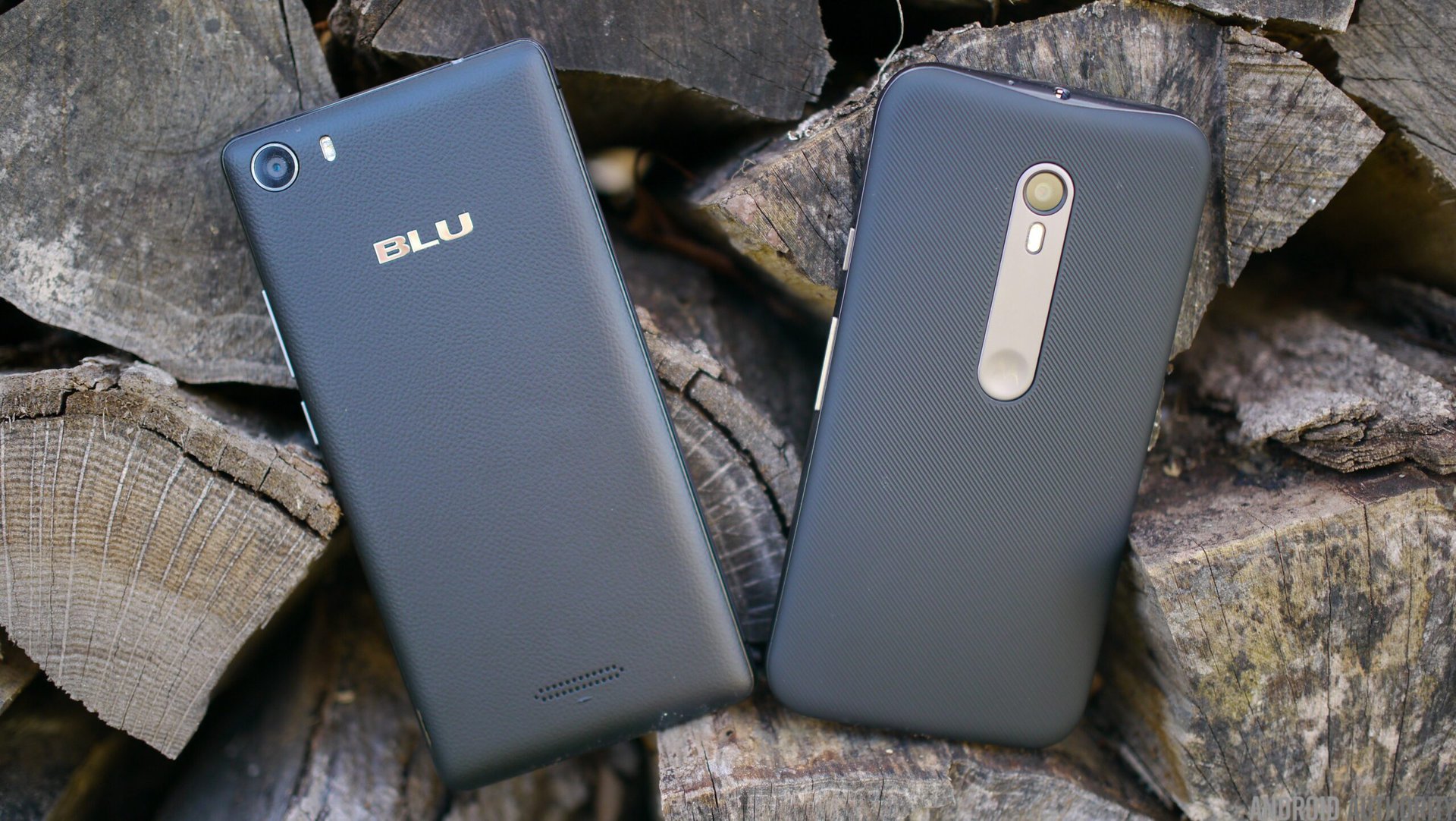
There has never been a better time to purchase a budget-friendly smartphone than right now.
As it turns out, all four major mobile service providers in the United States have almost completely done away with the standard two-year service agreements, this is giving customers more reason to go for inexpensive handsets. And that’s great, too, because low-cost smartphones are getting really good. No, seriously.
Just a few years ago, if you wanted to do anything on your smartphone that was worth doing – playing video games, streaming music, web browsing, etc. – you almost had to purchase a flagship smartphone. Now that’s changing. There are nearly hundreds of great low-budget smartphones available on the market these days.
Related: Best cheap Android phones
Another interesting trend when it comes to budget phones is screen size, with the majority of options packing 5.5-inch or even larger displays. For some, that’s the perfect size, but it’s not so great for those looking for a device that is easier to use with just one hand.
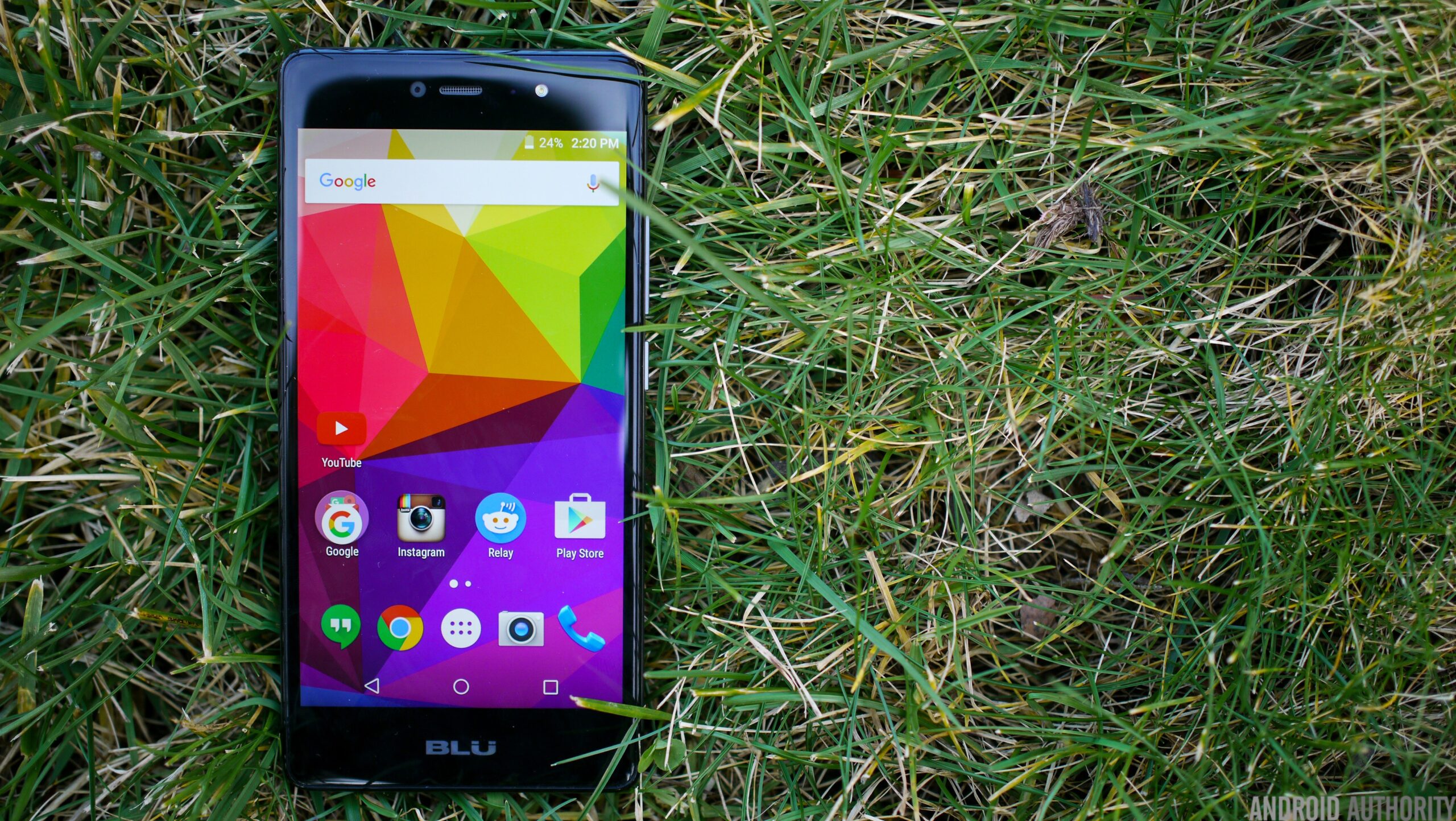
Thankfully, for those that prefer a budget-friendly device that is a bit more compact, there are still some solid options out there. Today we are going to be taking a look at two smartphones that fall in the 5 to 5.2-inch screen size range – the BLU Life One X and the Motorola Moto G (2015).
While the Moto G series has long been considered the “king of affordable handsets”, BLU’s latest phone was officially announced today, packing a pretty powerful punch, a sleek design, and an even cheaper price tag than the Moto G.
So has BLU’s new budget darling stolen the crown from Motorola? Let’s jump in and find out.
Specifications
| BLU Life One X | Motorola Moto G (2015) | |
|---|---|---|
Display | BLU Life One X 5.2-inch LCD display 1920 x 1080 resolution, 424ppi Corning Gorilla Glass 3 | Motorola Moto G (2015) 5.0-inch IPS LCD display 1280 x 720 resolution, 294ppi Corning Gorilla Glass 3 |
Processor | BLU Life One X 1.3GHz octa-core MediaTek MT6753 | Motorola Moto G (2015) 1.4GHz quad-core Qualcomm Snapdragon 410 |
GPU | BLU Life One X Mali T720 GPU | Motorola Moto G (2015) Adreno 306 |
RAM | BLU Life One X 2GB | Motorola Moto G (2015) 1, 2GB (depending on storage option) |
Storage | BLU Life One X 16GB | Motorola Moto G (2015) 8, 16GB |
MicroSD | BLU Life One X Yes, up to 64GB | Motorola Moto G (2015) Yes, up to 32GB |
Dual SIM | BLU Life One X Yes | Motorola Moto G (2015) Yes |
Networks | BLU Life One X 3G: 850/1700/1900/2100 4G: 2/4/7/12/17 Up to 150Mbps | Motorola Moto G (2015) GSM (XT1540) LTE (2, 4, 5, 7, 17) UMTS/HSPA+ (850, 1700/AWS, 1900, 2100 MHz) GSM/GPRS/EDGE (850, 900, 1800, 1900 MHz) UScellular, Virgin Mobile (XT1548) LTE (2, 4, 5, 12, 17, 25, 26) CDMA (800, 850, 1900 MHz) TD-LTE (41 TD2500) |
Software | BLU Life One X Android 5.1 Lollipop | Motorola Moto G (2015) Android 5.1.1 Lollipop |
Camera | BLU Life One X 13MP rear-facing camera, Phase Data Autofocus 5MP front-facing camera, LED flash | Motorola Moto G (2015) 13MP rear-facing camera, autofocus, dual-LED (dual tone) flash 5MP front-facing camera, auto-HDR |
Battery | BLU Life One X 2900mAh, non-removable | Motorola Moto G (2015) 2470mAh, non-removable |
Dimensions | BLU Life One X 186.8 x 72.8 x 8.4mm | Motorola Moto G (2015) 142.1 x 72.4 x 11.6mm, 155g |
Price | BLU Life One X $149 ($99 for limited time) | Motorola Moto G (2015) $179 |
Design
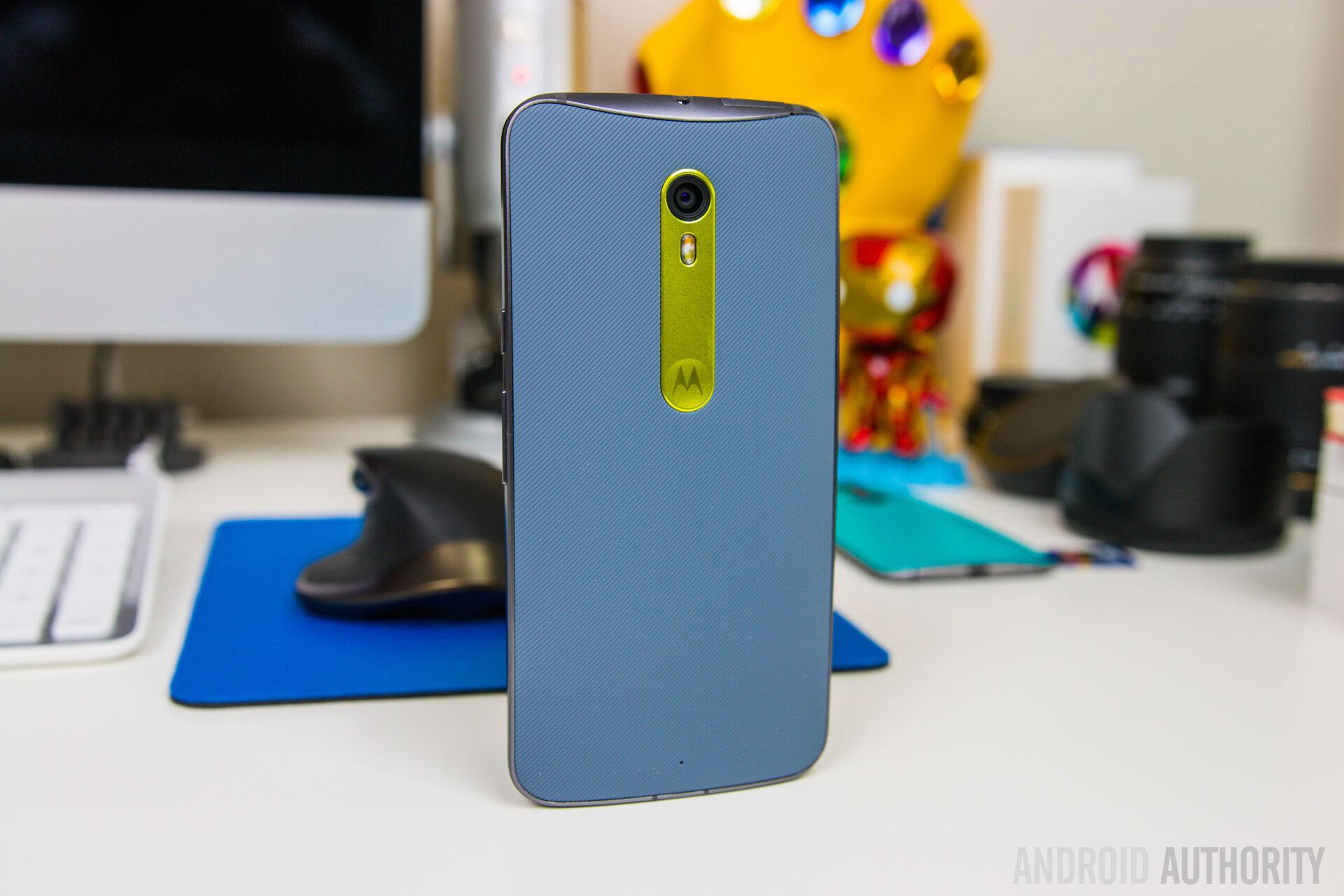
From a design perspective, the 2015 Moto G is almost identical to the previous two generations. Up front sits a single loudspeaker underneath the 5.0-inch 720p display. The whole front is also covered by Gorilla Glass 3. Motorola has also introduced the Moto G to Moto Maker this year, which means the back plate and colors you choose will depend entirely on whether or not you decide to customize the phone online.
The standard back plate is made of a nice rubbery material that’s quite grippy, but not so much so that it will get stuck in your pocket when trying to take it out. And although the device is made to look similar to the Moto X Style (aka Pure Edition) don’t be fooled – the metallic accent that surrounds the device is cheap and plasticky, which makes the device feel more affordable than premium.
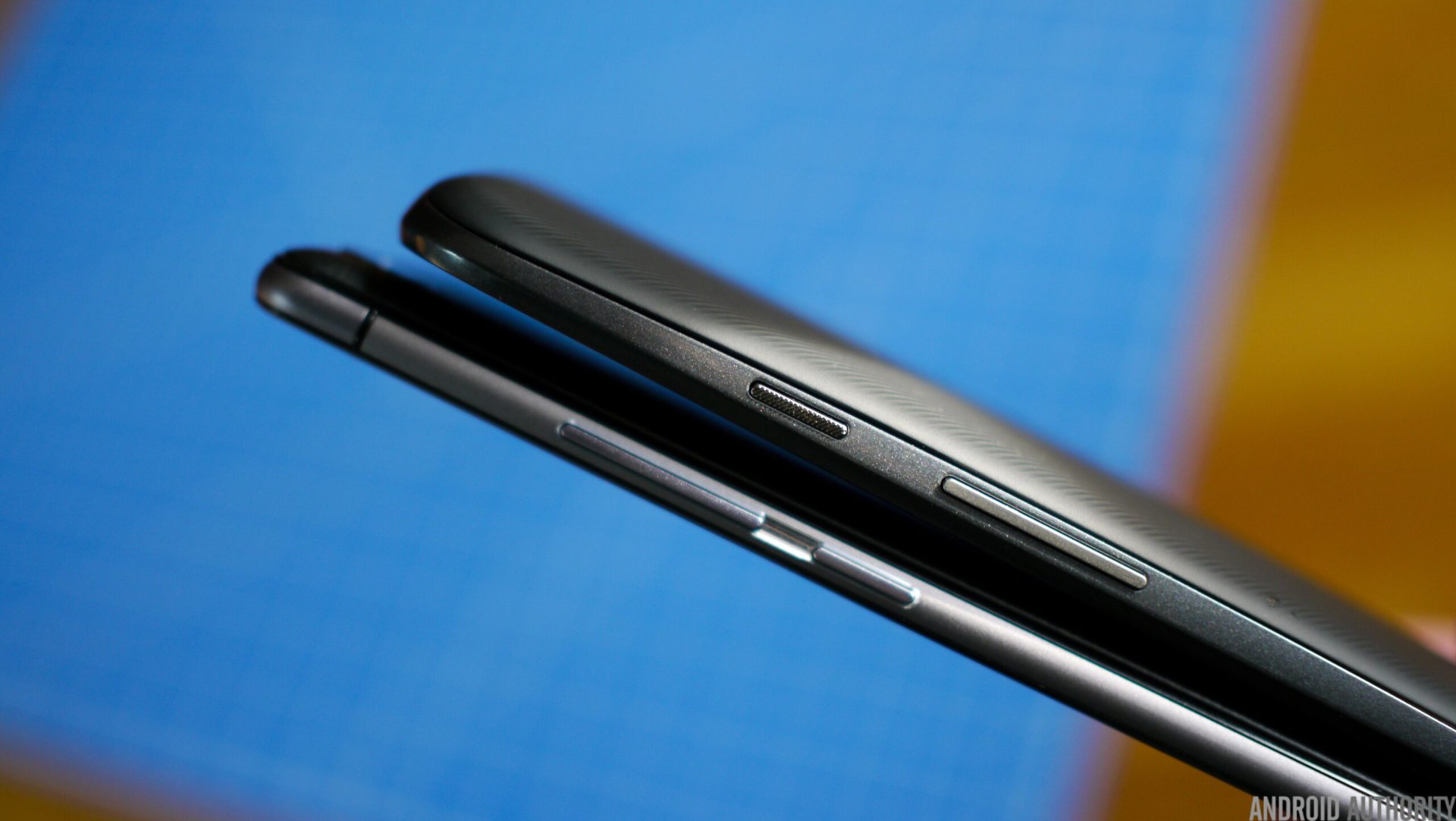
In contrast, the Life One X is made from a high-quality aluminum that feels great in the hand, largely due to the sand blasted matte finish that makes for an interesting texture. On the front sits a slightly curved 1080p panel covered in Gorilla Glass 3 for an extra layer of protection. Around back the device has a leather pattern that’s coated in a smooth paint layer. The result of this is a grippy, premium feel in the hand that we don’t typically see on smartphones in this price range.
Needless to say, if you care at all about “premium looks”, the new BLU Life One X is the champion here. While the Moto G looks fairly good for a “budget device”, the Life One X is a premium-feeling handset that would fool you into thinking it cost at least double its retail price.
Display

On the display front, the Moto G has a 5.0-inch LCD display with Gorilla Glass 3 and a 1280 x 720 resolution. While the 720p resolution is pretty decent for a screen this size, these days even budget-level handsets are starting to make the leap to 1080p, so it’s a bit disappointing to see that Motorola hasn’t caught up with the times.
On the other hand, the Life One X not only has a slightly bigger 5.2-inch LCD display, it also has a resolution of 1920 x 1080,putting this 1080p display above its budget-friendly competitor.
Processing power and hardware
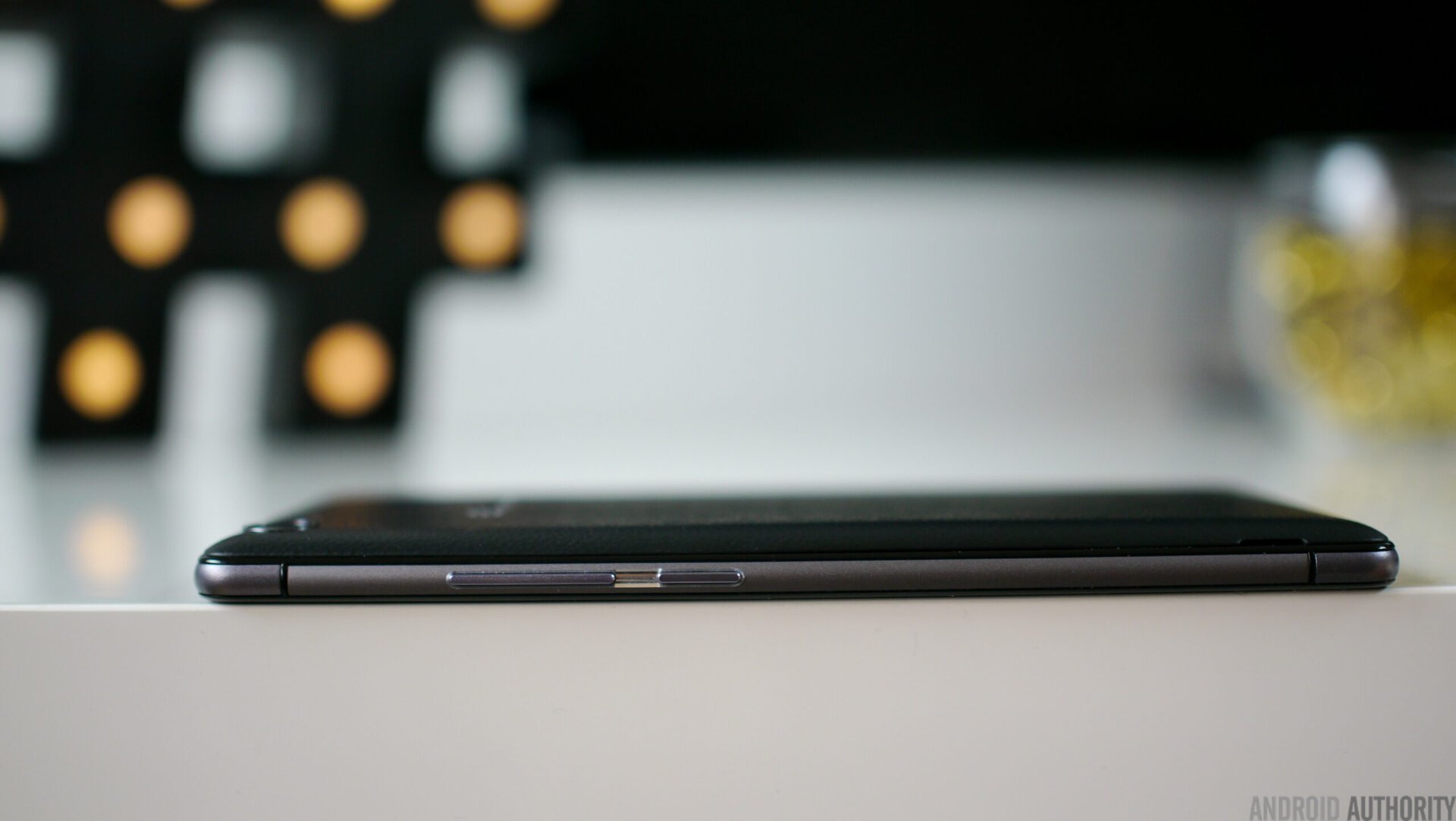
Starting off with the BLU Life One X, one of the headline features of this device is the 1.3GHz octa-core MediaTek MT6753 processor backed by 2 gigabytes of RAM. While we haven’t put the One X through our full review process just yet, in our time with the device we’ve found that this processing package is more than capable when it comes to general day to day tasks, multi-tasking, and gaming. It also has the advantage of a 2,900 mAh battery, which is pretty large for a phone of the size/budget.
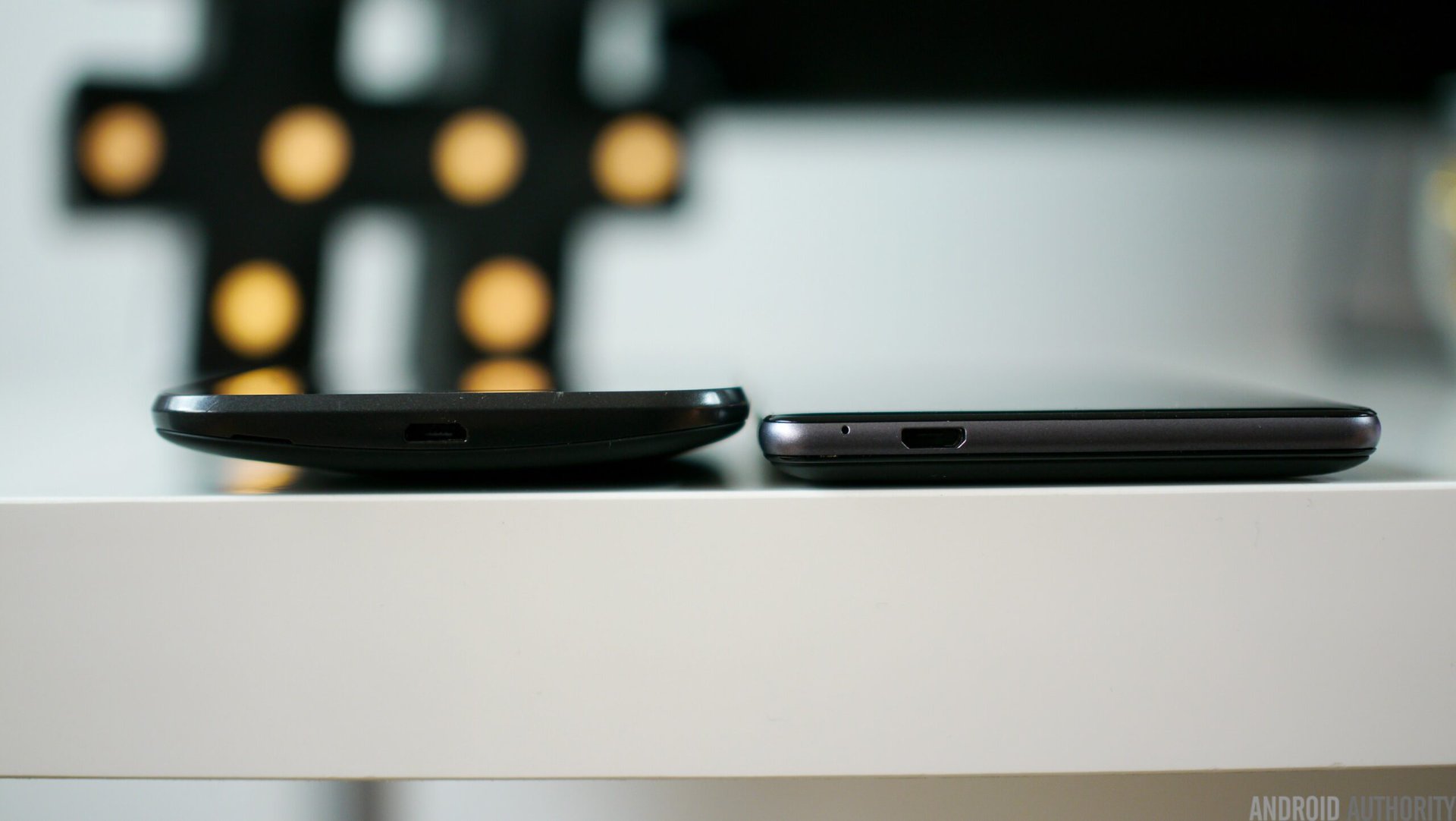
The Moto G offers a very different processing package from BLU’s offering, with a 1.4GHz quad-core Qualcomm Snapdragon 410 and 1/2GB of RAM, depending on whether you pick the model with 8 or 16GB of on-board storage. Regardless of which model you choose, you’ll get the same 2470mAh battery, which is a little smaller than we’d like to see.
The MediaTek-powered BLU Life One X outperforms the Moto G in every benchmarking test you throw at it
The 410 is a good processor, and it’s proven itself in many other handsets. We didn’t really experience too many performance hiccups in our full review o the device, but we reviewed the higher-end model that runs $219 and comes with 2GB RAM. The lower-end model can be found for a bit cheaper at around $180, but we can’t help but feel that 1GB RAM is just too little for a modern smartphone and so expect a somewhat less impressive experience if you plan to opt for that model.
Okay, but which chip is the better one? While Qualcomm has a reputation for being one of the best chip makers in the industry, MediaTek has really upped the ante over the last year or so. The end result is that the MediaTek-powered BLU Life One X actually outperforms the Moto G in every benchmarking test you throw at it — as you can see for yourself below.
In AnTuTu, the BLU Life One X scored an overall ranking of 31,367 vs the 22,767 for the Moto G.
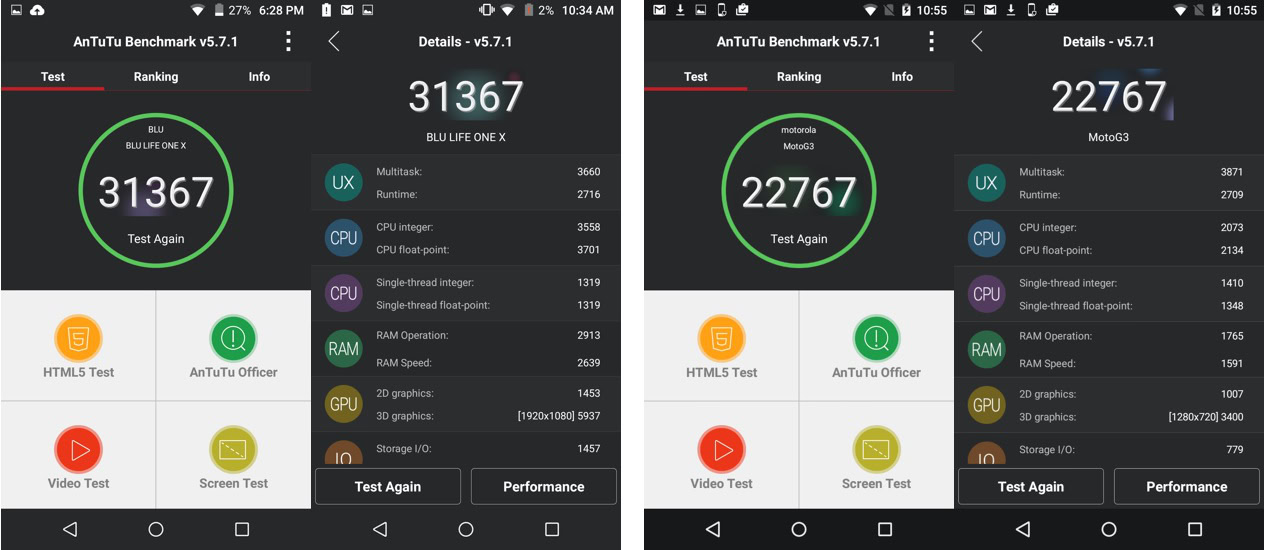
Geekbench 3 pained a similar picture with the Life One X achieving a single-core score of 629 and multi-core score of 2842, vs the Moto G’s 524 and 1580 scores respectively.
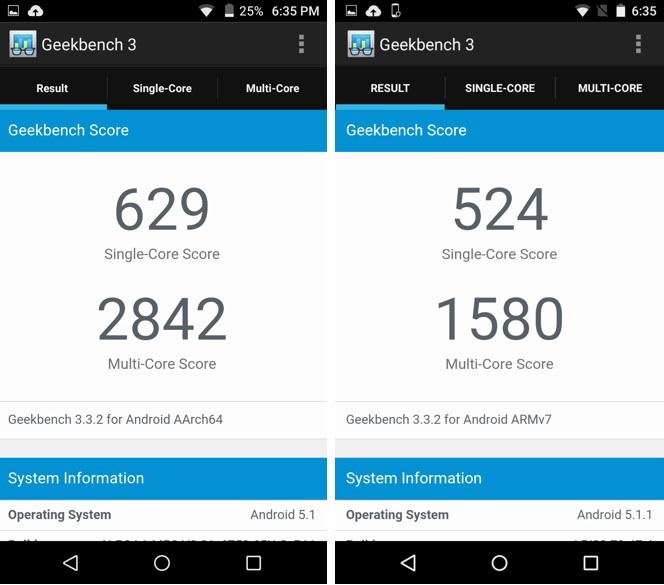
Turning to Vellamo, the Chrome browser experience was put to the test, and as you can see, the BLU Life One X had a score of 2669, versus 2042 for the Moto G.

While we already knew the BLU Life One X had a bigger battery than the Moto G, that doesn’t always equate to better battery life. Thankfully for BLU, in this case it does. According to the Geekbench 3 battery test metric, the BLU Life One X had a battery runtime of 8:48:20 and a battery score of 3598, vs 7:00:40 and a score of 2804 for the Moto G.
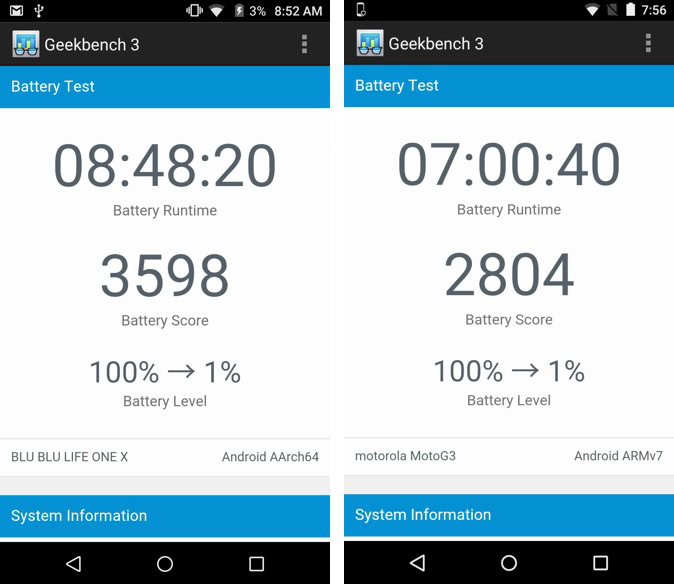
Lastly, both BaseMark OS II and GFX testing were ran, showing a similar story of better performance from the BLU Life One X when compared to the Moto G.
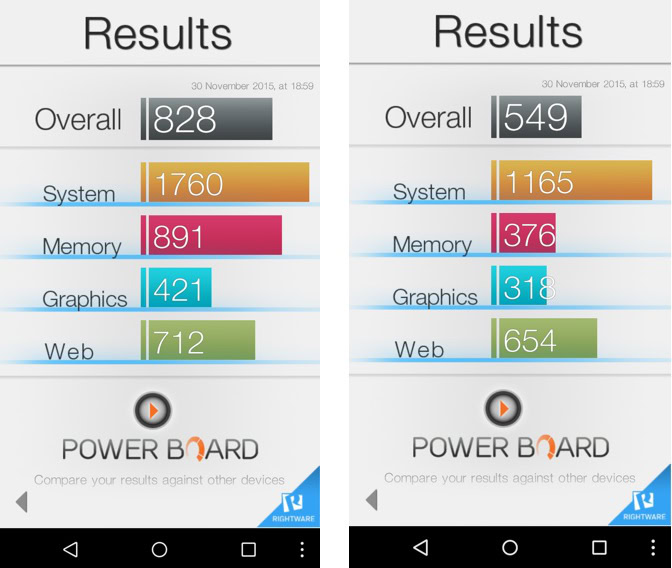
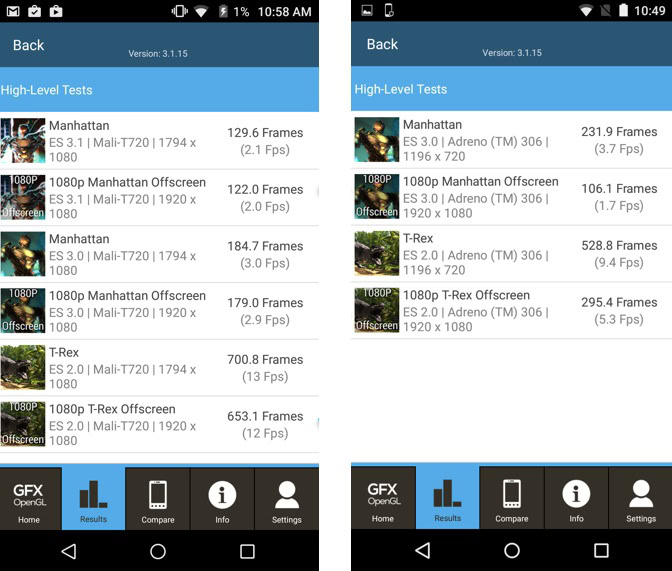
While benchmark tests don’t always tell the full story, it is a great indicator for general performance and we have to admit we are pretty impressed by what BLU managed to achieve with its latest entry-level handset.
Camera
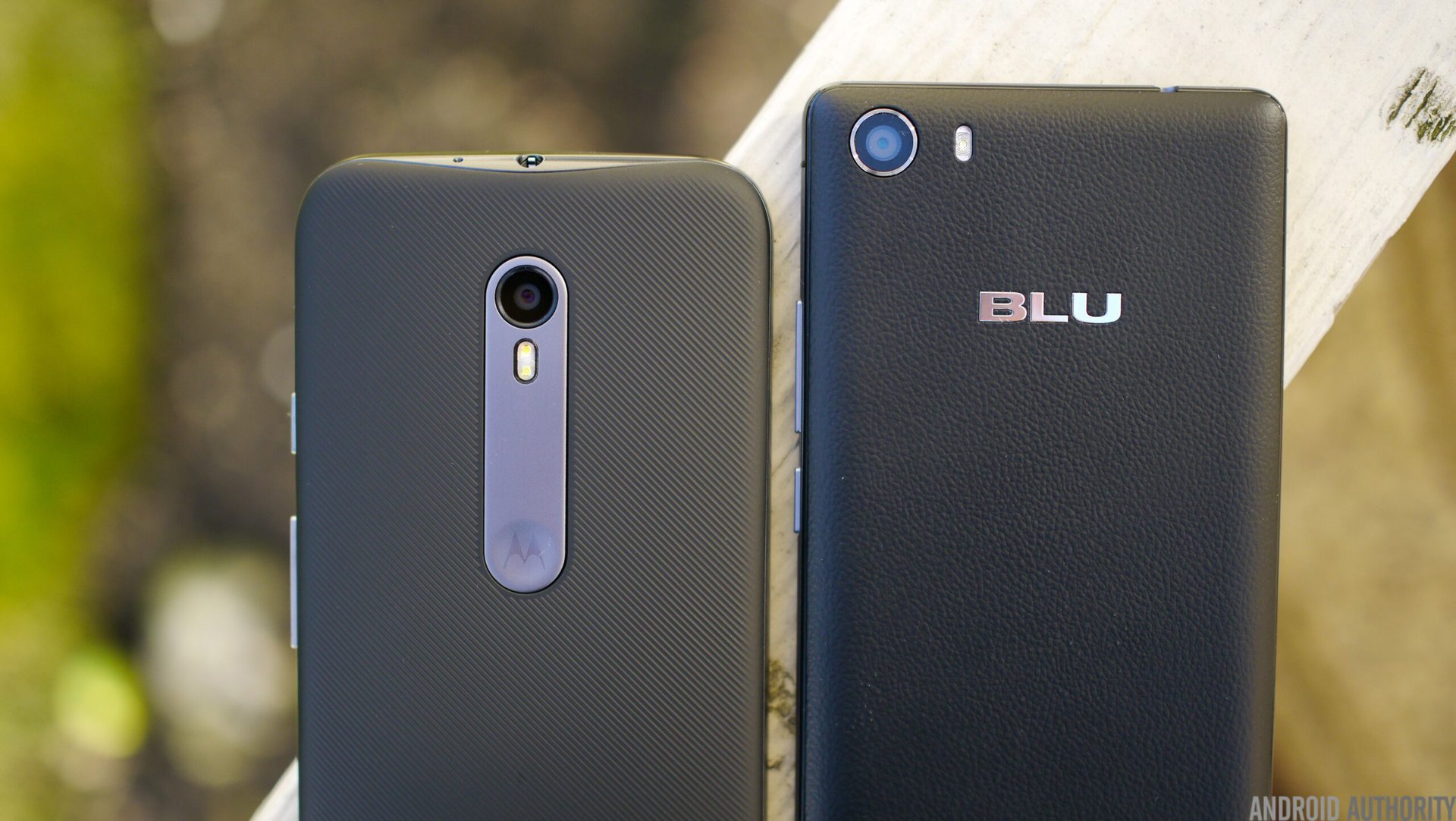
Both the Moto G and the BLU Life One X have pretty solid cameras, especially given the affordable nature of these devices.
Starting off with BLU’s Life One X, it comes with a 13MP rear-facing camera with an added Blue Optical Filter that will give your photos a nice finishing touch. It also comes with handy features such as Phase Detection Autofocus, Panorama, Picture-in-Picture mode, and face beautification, which is definitely a nice touch. The camera app on the BLU device is quite simple and intuitive. The shutter button, video button and gallery shortcuts are found on the right side of the app, and you can adjust your camera’s settings on the left side.
Additionally, the Life One X comes with a 5MP front-facing camera which has a wide-angle lens, making it easier to fit everyone in a single photo. Also, for low-light situations, it has a front-facing flash.
The Moto G (2015) comes with a 13MP rear-facing camera as well. And interestingly enough, this is the same Sony IMX214 sensor found in Google’s 2014 flagship Nexus 6. The Nexus 6 had optical image stabilization, however, and the Moto G does not, which can be a big problem at times.
In daylight, the camera produces colors that are vibrant and captures an impressive amount of detail. In particular, HDR mode makes a big difference to images and while some other phones do very little in HDR mode, the Moto G does a really good job in lighting up shadows. Sadly, as the sun drops so does the camera performance. Daylight images have very little noise but a lack of light results in focal problems and digital noise.
Motorola’s camera app is far from the best out there. It’s simple, almost to a fault. Switching modes can be particularly difficult if you’re in a hurry. And now that the camera is pretty good this time around, we would have liked to see more granular controls over specific aspects of the camera, such as white balance and shutter speed.
Software

The BLU Life One X runs Android 5.1 Lollipop with BLU’s Carefree launcher on top. The Carefree launcher is an OEM skin that we really like – it brings some nice Material Design tweaks to the user interface, as well as a bevy of smart gestures, custom applications, and more. Plus, BLU has previously said that it’s making timely software updates a priority, so hopefully that means an update to Android 6.0 Marshmallow is in the cards.
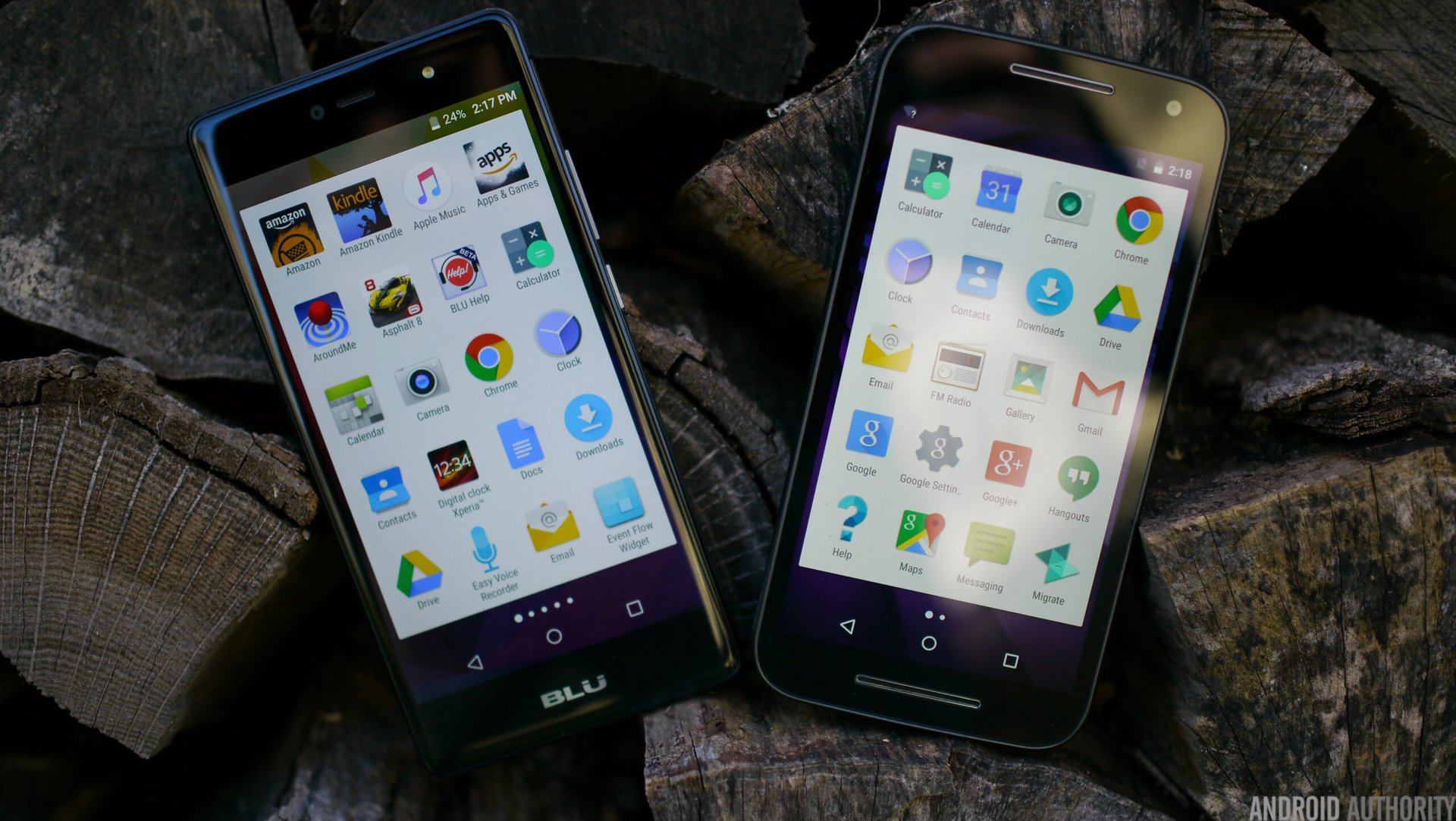
Motorola’s Moto G (2015) is in a very similar boat. It’s running Android 5.1 Lollipop and has a very stock-like nature to it. There are a few handy Motorola applications thrown into the mix that really help with the overall experience, too. Unfortunately Motorola hasn’t been incredibly upfront about pushing out timely software updates as of late, so some folks are nervous that they won’t be able to see Marshmallow for some time.
Pricing and final thoughts

Going down the list, the Moto G proves itself to be an excellent budget-friendly smartphone. That said, the BLU Life One X manages to best it in several key areas: design, display, and even the processing package.
Of course, the Moto G has some pretty big strengths of its own and remains an excellent choice for fans of the brand. Some solid extras found with the Moto G include waterproofing and Moto Maker customization.
Ultimately, for those in the market for a truly affordable handset, the real winner comes down to pricing. In that metric, the BLU Life One X wins out with a price tag of just $149. Meanwhile, the Moto G starts out at $179, but the model with same storage/RAM actually is priced at $219 — making it $70 more than BLU’s latest contender. As if the pricing difference wasn’t already big enough, BLU is also doing an introductory sale from 12/10 to 12/12, ending at midnight EST where the phone will be offered for $50 off, bringing it down to just $99! That’s a heck of a deal to say the least.
You really can’t go wrong with either of these handsets, though we can’t help but feel like BLU’s new Life One X has raised the bar when it comes to sub-$200 handsets. And at the sale price, the BLU Life One X is really a no-brainer.